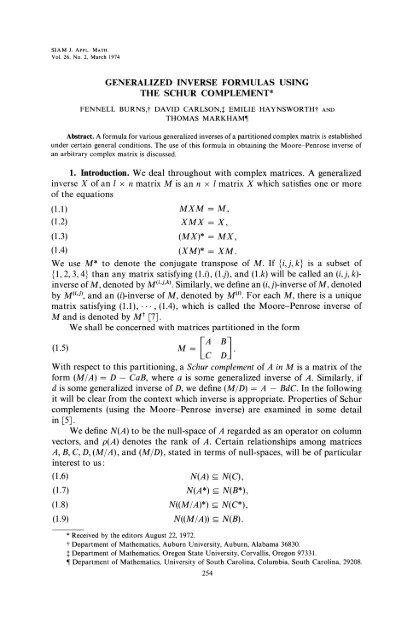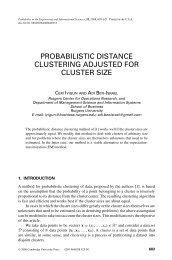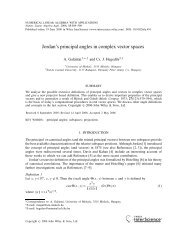Generalized inverse formulas using the Schur ... - Benisrael.net
Generalized inverse formulas using the Schur ... - Benisrael.net
Generalized inverse formulas using the Schur ... - Benisrael.net
You also want an ePaper? Increase the reach of your titles
YUMPU automatically turns print PDFs into web optimized ePapers that Google loves.
SIAM J. APPL. MATH.Vol. 26, No. 2, March 1974GENERALIZED INVERSE FORMULAS USINGTHE SCHUR COMPLEMENT*FENNELL BURNS,- DAVID CARLSON,: EMILIE HAYNSWORTH- ANDTHOMAS MARKHAMAbstract. A formula for various generalized <strong>inverse</strong>s of a partitioned complex matrix is establishedunder certain general conditions. The use of this formula in obtaining <strong>the</strong> Moore-Penrose <strong>inverse</strong> ofan arbitrary complex matrix is discussed.1. Introduction. We deal throughout with complex matrices. A generalized<strong>inverse</strong> X of an n matrix M is an n matrix X which satisfies one or moreof <strong>the</strong> equations(1.1)MXM M,(1.2)XMX X,(1.3)(MX)* MX,(1.4)(XM)* XM.We use M* to denote <strong>the</strong> conjugate transpose of M. If {i,j,k} is a subset of1, 2, 3, 4} than any matrix satisfying (1.i), (1.j), and (1.k) will be called an (i, j, k)-<strong>inverse</strong> of M, denoted by Mi’’k). Similarly, we define an (i, j)-<strong>inverse</strong> of M, denotedby M"’), and an (/)-<strong>inverse</strong> of M, denoted by M "). For each M, <strong>the</strong>re is a uniquematrix satisfying (1.1), ..., (1.4), which is called <strong>the</strong> Moore-Penrose <strong>inverse</strong> ofM and is denoted byWe shall be concerned with matrices partitioned in <strong>the</strong> formWith respect to this partitioning, a <strong>Schur</strong> complement of A in M is a matrix of <strong>the</strong>form (M/A) D CaB, where a is some generalized <strong>inverse</strong> of A. Similarly, ifd is some generalized <strong>inverse</strong> of D, we define (M/D) A BdC. In <strong>the</strong> followingit will be clear from <strong>the</strong> context which <strong>inverse</strong> is appropriate. Properties of <strong>Schur</strong>complements (<strong>using</strong> <strong>the</strong> Moore-Penrose <strong>inverse</strong>) are examined in some detailin [5]Ẇe define N(A) to be <strong>the</strong> null-space of_ A regarded as an operator on columnvectors, and p(A) denotes <strong>the</strong> rank of A. Certain relationships among matricesA, B, C, D, (M/A), and (M/D), stated in terms of null-spaces, will be of particularinterest to us:(1.6) N(A) N(C),(1.7) N(A*) N(B*),(1.8) N((M/A)*) N(C*),(1.9) N((M/A)) N(B).-Received by <strong>the</strong> editors August 22, 1972.Department of Ma<strong>the</strong>matics, Auburn University, Auburn, Alabama 36830.: Department of Ma<strong>the</strong>matics, Oregon State University, Corvallis, Oregon 97331.Department of Ma<strong>the</strong>matics, University of South Carolina, Columbia, South Carolina, 29208.254
Note that (1.6) is equivalent toGENERALIZED INVERSE FORMULAS 255(1.10) C CA(1)A for every A (),that (1.7) is equivalent to(1.11) B AA(I)B for every A (1),and similarly for (1.8) and (1.9). We shall say that M satisfies (N1) if (1.6) and (1.7)hold, (N3) if (1.7) and (1.8) hold, (N4) if (1.6) and (1.9) hold, and (N) if m satisfies(N3) and (N4). The numbering of <strong>the</strong> conditions (N1), (N3), (N,) correspondswith <strong>the</strong> numbering of <strong>the</strong> equations for <strong>the</strong> Moore-Penrose <strong>inverse</strong>. As will beseen (Theorem 1 (ii)) no condition is needed on M for existence of an M (2) in <strong>the</strong>form (2.1) so (N2) is omitted.2. A formula for generalized <strong>inverse</strong>s. Suppose M is in form (1.5), whereA is p q and D is (l p) (n q). Consider a matrix of <strong>the</strong> form(2.1) rnIa + aBsCa-sCaaBsl swhere a is q x p and s is (n- q) (l- p). We shall show that under certainconditions m is a generalized <strong>inverse</strong> of M.Let S D CaB. The following statements are easily verified (see Appendix):If al, a2 are (1)-<strong>inverse</strong>s of A, <strong>the</strong>n CalB CazB if (1.6) and (1.7) hold. Thusunder certain conditions S is independent of <strong>the</strong> choice of a. However, in <strong>the</strong> sequelwe shall always assume that S is given in terms of a specific choice of a.If a, s satisfy (1.1) relative to A, S respectively, <strong>the</strong>n m satisfies (1.1) relative toM if and only if M MmM 0 or"(2.2)(2.3)(I Ss)C(I aA) O,(I Aa)B(I sS) O,(2.4) (I Aa)BsC(I aA) O.Then m satisfies (1.1) relative to M if M satisfies any one of (N1) or (N3) or (N4).If a, s satisfy (1.2) relative to A, S respectively, <strong>the</strong>n m always satisfies (1.2)relative to M.If a, s satisfy (1.3) relative to A, S respectively, <strong>the</strong>n m satisfies (1.3) relative toM if M satisfies (N3).If a A (1’3), s S(1’3), and m M (1’3), <strong>the</strong>n (Mm)* Mm implies(2.5) [(I Ss)Ca]* (I- Aa)Bswhich toge<strong>the</strong>r with (2.3) implies (1.7) holds. Moreover, <strong>the</strong> conjugate transposeof (2.5) in view of (2.2) shows that (1.8) must hold.If a, s satisfy (1.4) relative to A, S respectively, <strong>the</strong>n m satisfies (1.4) relative toM if M satisfiesSimilarly if a A (1’4), s S(1’4), and m M(1’4), <strong>the</strong>n M satisfiesTherefore we have <strong>the</strong> following <strong>the</strong>orem.
256 F. BURNS, D. CARLSON, E. HAYNSWORTH AND T. MARKHAMTHEOREM 1.(i) If a A (1) and s S1, <strong>the</strong>n m M 1) if M satisfies (N1) or (N3) or (N4).(ii) If a A 2 and s St2, <strong>the</strong>n m M2.(iii) Ira A (j and s S tj <strong>the</strong>n m M tj if M satisfies (Nj),j 3, 4.(iv) If a A tl’j) and s Stl’j, <strong>the</strong>n m M tl’j if and only if M satisfies(Nj),j 3, 4.(v) If A A and s S t, <strong>the</strong>n m M* if and only if M satisfies (N).Remark. The conditions for obtaining any M (i’j) or M (i’j’k) in terms of correspondinga and s can be obtained as immediate corollaries. For example, ifa A (l’a’’) and s S(l’a’’), <strong>the</strong>n m M (1’a’4) if and only if M satisfies (N).P. Bhimasankaram [4] has <strong>formulas</strong> for M (1) and M (1’2) which are identicalwith ours under conditions equivalent to (2.2), (2.3), (2.4). He has shown (as weremarked above) that (2.2), (2.3), (2.4) are necessary and sufficient for existence ofM (1) in <strong>the</strong> form (2.1). However, Theorem gives a more complete picture forany M (i), M "’j), M (i’j’k) <strong>inverse</strong>. Bhimasankaram has proved some o<strong>the</strong>r interestingresults for special cases.Rohde [9] has proved that if a, s are (1) or (1, 2) or (1, 2, 3) or Moore-Penrose<strong>inverse</strong>sof A, S, <strong>the</strong>n m is <strong>the</strong> corresponding <strong>inverse</strong> of M when M is positivesemidefinite Hermitian and partitioned symmetrically (and, for <strong>the</strong> (1, 2, 3) orMoore-Penrose <strong>inverse</strong>, with <strong>the</strong> assumption that D is nonsingular and p(M)p(A) + p(D)). As was proved by Albert [1] in <strong>the</strong> real case (his proofs carry_that m M* for certain 2n x 2n matrices M.We say that M satisfies (N’) if, for some specified (M/D),(1.6’) N(D) N(B),(1.7’) N(D*) N(C*),over to <strong>the</strong> complex case) such positive semidefinite Hermitian M always satisfy(1.6) and (1.7); and positive definite Hermitian M satisfy (1.8) and (1.9), as(M/A) D B*A*B is also positive definite Hermitian. Ben-Israel [2] has shown_ N((M/D)*) N(B*),(1.9’) N((M/D)) N(C).Given M in form (1.5), where A is p x q and D is (l p) x (n q), if we considera matrix of <strong>the</strong> formI (2.6) m,-dCt d + dCtBd]where is q x p and d is (n q) x (1 p), and let T A BdC, we obtain aresult analogous to Theorem 1. The following corollaries apply specifically to <strong>the</strong>Moore-Penrose <strong>inverse</strong>COROLLARY 1. If M satisfies both (N) and (N’), <strong>the</strong>nM*=[ (2.7) (M/D)*A*B(M/A)*]-D*C(M/D)*Proof. The proof follows from Theoremabove, by <strong>the</strong> uniqueness of M*.and <strong>the</strong> analogous result mentioned
GENERALIZED INVERSE FORMULAS 257COROLLARY 2. If M satisfies (N), <strong>the</strong>n(2.8) (M/(M/A)) A,and if M satisfies (N’), <strong>the</strong>n(2.9) (Mt/(M/D)t)t= D.Proof. To prove (2.8) apply <strong>the</strong> definition of <strong>the</strong> <strong>Schur</strong> complement (M/D)to <strong>the</strong> matrix M as represented in (2.1), with a A t, s (D CAtB) t, to obtain(Mt/(M/A) t) A + AtB(M/A)tCA A B(M/A)t)(M/A) (M/A)tCA t)__At.(2.8) follows as (At) A. The proof of (2.9) is similar.COROLLARY 3. If M satisfies (N), so that M has <strong>the</strong> form (2.1), with a A t,s (D- CAtB) t, <strong>the</strong>n M satisfies (N’). Similarly, if M satisfies (N’), <strong>the</strong>n Mhas <strong>the</strong> form (2.6), with d D t, (A BD C) t, and M satisfies (N).Proof. If M satisfies (N), and M has <strong>the</strong> stated form (2.1), clearly (1.6’) and(1.7’) hold for M t. Since, by Corollary 2, we have (Mt/(M(S))t) A t, (1.8’) and(1.9’) also hold for Mr; hence M satisfies (N’). The proof if M satisfies (N’) issimilar.3. The Moore-Penrose <strong>inverse</strong> of an arbitrary matrix. Mitra [11] and,independently, Zlobec [10] have proved that for any x n matrix M,(3.1) M M*QM* for any Q (M*MM*)1).Thus <strong>the</strong> computation of <strong>the</strong> unique matrix M may be reduced to <strong>the</strong> computationof a (1)-<strong>inverse</strong> Q (which is a solution of <strong>the</strong> system of linear equations(M*MM*)Q(M*MM*) M*MM*; cf. [3]).An alternative representation of M was given by Decell [6]"(3.2) M M*PIMP2M* for any P1 (MY*)1), P2 (M’M).In this case, MY* and M*M are positive semidefinite; and <strong>the</strong> calculation ofP1 and Pe may, by our Theorem 1 (in <strong>the</strong> special case proved by Rohde), be reducedto <strong>the</strong> calculation of (1)-<strong>inverse</strong>s of four matrices of lower order. In <strong>the</strong> next section,we give ano<strong>the</strong>r result which is related to <strong>the</strong> computation of M t.4. The Moore-Penrose <strong>inverse</strong> when p(M) p(A). Suppose M is in form(1.5), and that p(M) p(A). This implies that (1.6) and (1.7) hold; that for anya A1, (M/A) D CaB 0;and thatDefineM=IAcIo[A B].R M[A B]* A*AA* + C’CA* + A*BB* + C*CaBB*.One <strong>the</strong>n can compute thatM*MM* [A B]*a*Ra*[AcI *IR Ra* C*B*a*R B*a*Ra*C*3
258 F. BURNS, D. CARLSON, E. HAYNSWORTH AND T. MARKHAMVrr=R (1), we haveM*MM*[ -o[M*MM*=M*MM*.By <strong>the</strong> Zlobecresult (3.1), M M* M* [A B]*r CWe have proved <strong>the</strong> following <strong>the</strong>orem.T-mORFM 2. Suppose M is in form (1.5), and that p(M)p(A). Then M satisfies(1.6) and (1.7), and M [A B]*r where r M[A B]*CRemark. This generalizes a result of Penrose [8] (rediscovered by Zlobec [10]),in which it was assumed that A was nonsingular. Using permutations of rows andcolumns, any singular matrix M can be put in form (1.5) with p(A)= p(M).As suggested by Penrose in [8], this gives ano<strong>the</strong>r method for <strong>the</strong> calculation ofM for any singular M, in terms of <strong>the</strong> calculation of a (1)-<strong>inverse</strong> of a matrixsmaller than, M.5. Examples. To illustrate <strong>the</strong> <strong>formulas</strong>, here, we compute <strong>the</strong> Moore-Penrose <strong>inverse</strong> of three matrices. Let Iand J0I J1. Suppose M The matrix M satisfies conditions (N) of TheoremJ 0since I is nonsingular and (M/I)= -2J. Due to <strong>the</strong> fact that (M/I)*= --Jone obtains I 1/2J 1/4JM1/4J --J]The conditions of Theorem 2 are not satisfied since <strong>the</strong> rank of M is three.2. Suppose M-- Here, nei<strong>the</strong>r <strong>the</strong> conditions (N) nor (N’) are0 0satisfied. However, Theorem 2 is applicable and one can compute3. Suppose M The conditions (N) or (N’) are not satisfied andITheorem 2 is not applicable. However, in any case, we can use (3.2) with Theorem 1to obtainM*--[ 1/4J I-1/2J]Appendix. Computations of Theorem 1. Using M as in (1.5) and m in (2.1)with S D- CaB we find <strong>the</strong> following computations are useful in verifyingTheorem 1:Mm[Ao-(I- Aa)BsCa (I- Aa)BsSs)Ca Ss _1’1/2jmM= aA aBsC(I aA) aB(I sS)lsC(I aA) sS
GENERALIZED INVERSE FORMULAS 259mMmMmMAaA + (I Aa)BsC(I aA)(I- Ss)CaA + SsCAaA + (! Aa)BsC(! aA)CaA + SsC(I- aA)AaB + (IAa)BsSi(I Ss)CaB + SsDABsS + AaB(I- sS)lCaB + SsSaAa aBsC(a aAa)](I + BsCa) aB(s sSs)CasC(a aAa)(I + BsCa) sSsCa-aAaBs + aBsC(a aAa)Bs + aB(s sSs)lsSs sC(a aAa)BsREFERENCES[1] ARTHUR ALBERT, Conditions for positive and nonnegative definiteness in terms ofpseudo<strong>inverse</strong>s,this Journal, 17 (1969), pp. 434-440.[2] ADI BEN-IsRazI, A note on partitioned matrices and equations, SIAM Rev., 11 (1969), pp. 247-250.I3] ADI BN-IsRazI aND A. CHaRNS, An explicit solution of a special class of linear programmingproblems, Operations Res., 16 (1968), pp. 1166-1175.[4] P. BHIMaSaNKaRaM, On generalized <strong>inverse</strong>s ofpartitioned matrices, Sankhy Ser. A, 33A (1971),pp. 311-314.[5] DAVID CARLSON, EMILIE HaYNSWORTH AND THOMAS MARKHAM, A generalization of <strong>the</strong> <strong>Schur</strong>complement by means of <strong>the</strong> Moore-Penrose <strong>inverse</strong>, this Journal, 26 (1974), pp. 169-175.[6] HNR’’ DCLL, JR., An alternate form of <strong>the</strong> generalized <strong>inverse</strong> of an arbitrary complex matrix,SIAM Rev., 7 (1965), pp. 356-358.[7] R. PNROSE, A generalized <strong>inverse</strong> for matrices, Proc. Cambridge Philos. Soc., 51 (1955), pp.406-413.[8], On best approximate solutions of linear matrix equations, Ibid., 52 (1956), pp. 17-19.[9] CHaRIZS ROHDW, <strong>Generalized</strong> <strong>inverse</strong>s of partitioned matrices, this Journal, 13 (1965), pp.1033-1035.[10] SaNJO ZIOBZC, An explicit form of <strong>the</strong> Moore-Penrose <strong>inverse</strong> of an arbitrary complex matrix,SIAM Rev., 12 (1970), pp. 132-134.(11] S. K. MITRa, On a generalized <strong>inverse</strong> of a matrix and applications, Sankhy Ser. A, 30 (1968),pp. 107-114.






